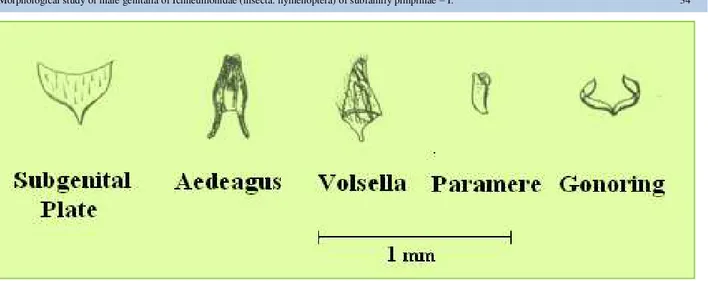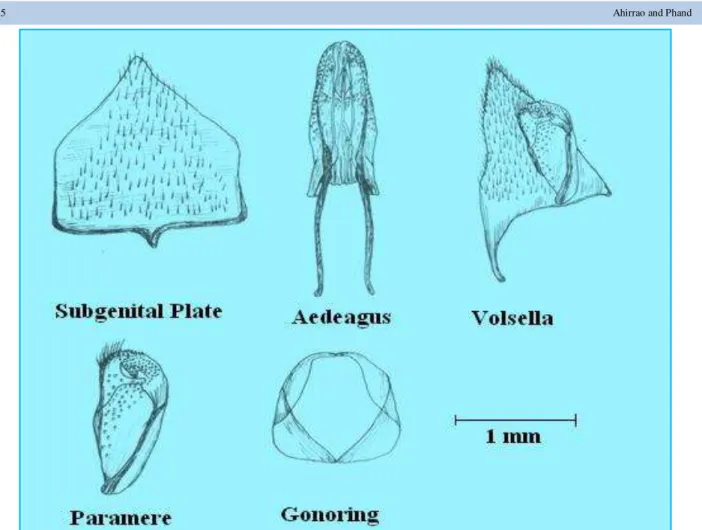_________________________________________________________ Journal of Experimental Biology and Agricultural Sciences http://www.jebas.org
KEYWORDS
Morphology
Male genitalia
Ichneumonidae
Hymenoptera
Pimplinae
Eruga Townes
Coccygomimus Saussure
ABSTRACT
The male genitalia of the genus of Eruga Townes and Coccygomimus Saussure (Ichneumonidae: Pimplinae) are described in present study. The Pimplinae is one of the important subfamily of Ichneumonidae. This subfamily Pimplinae contains 62 genera with 927 species in the Indo-Australian region. In insects male genitalia are organs with the process of mating. The male genitalia are one of the sound character in classifying various genera and species of the Ichneumonidae. The male genitalia of the species of Eruga Townes and Coccygomimus Saussure (Ichneumonidae : Pimplinae) are described.
Deepak L Phand
#and Dhairyashil V Ahirrao
*,#Post Graduated Department of Zoology, S. S. V. P. S. L. K. Dr. P. R. Ghogrey Science College Dhule, M.S. India
Received – July 18, 2014; Revision – August 24, 2014; Accepted – November 25, 2014 Available Online – February 20, 2015
MORPHOLOGICAL STUDY OF MALE GENITALIA OF ICHNEUMONIDAE
(INSECTA: HYMENOPTERA) OF SUBFAMILY PIMPLINAE
–
I
E-mail: dv2ahirrao@gmail.com (Dhairyashil V. Ahirrao)
Peer review under responsibility of Journal of Experimental Biology and Agricultural Sciences.
* Corresponding author (#Both authors contributed equally)
Journal of Experimental Biology and Agricultural Sciences, February - 2015; Volume – 3(1)
Journal of Experimental Biology and Agricultural Sciences
http://www.jebas.org
ISSN No. 2320 – 8694
1 Introduction
In the insect genitalia are blunt and situated externally. Male genitalia are the organs concerned with the process of mating. The male genitalia are one of the sound characters for classifying various genera and species of the Ichneumonidae. Peck (1937) and Pratt (1939) studied the detailed structure of Ichneumonidae male genitalia.
The Pimplinae is one of the important subfamily of Ichneumonidae, which was known earlier as Ephialtinae. The subfamily Pimplinae is more common in the South East Asia, Java, Oriental and Australian regions (Gupta, 1987). This subfamily Pimplinae contains 62 genera with 927 species in the Indo-Australian region (Gupta, 1987). Peck (1937) worked on the male genitalia of Pimplinae results of the study associated post-segmental segments of the taxa and revealed the figures of male genital complexes were also revealed. This study did not illustrate the diagrammatic dorsal view of genitalia of some species but also the external ventral view of the aedeagus. The dorsal view of gonocordo of Megarhyssa citraria forms the parts of Pecks (1937) study. Phand & Ahirrao (2013) work on the male genitalia of the genus of
Xanthopimpla Saussure (Ichneumonidae: Pimplinae). They described male genitalia of Xanthopimpla punctata (Fabricus, 1781), Xanthopimpla stemmator (Thunberg, 1822) and
Xanthopimpla honorata parahonorata a subspecies nov., (Heble, 1981)were studied.
The genus Eruga Towns (1960) belongs to the tribe Polyshinectini of the subfamily Pimplinae. This is a moderate sized, distributed in Nearctic, Neotrophic, Ethiopian and Oriental regions. Eruga asiansis, a new species described by
Nikam (1986) has been explored. The genus Coccygomimus
Saussure (1892) belongs to the tribe Ephialtini of the subfamily Pimplinae. Coccygomimusleothoë Cameron (1897) is a cosmopolitan species occurring in the Oriental region and common throughout India. Many workers attempt the taxonomy and biology of the species. The aspect of the male genitalia was studied by Gupta & Saxena (1987). Many views on the nomenclatorial system of the different parts of the male genitalia exist. To avoid the confusion of various terms formerly used by Boulange Henry (1924) and Snodgrass (1941) were examined. However, the widely accepted terms by Peck (1937) have been used for convenience.
The little work has been done in concern with insect genitalia, the present study is concerned with the whole genitalia of the taxa along with an adequate description. In the present study the male genitalia of subfamily Pimplinae has been exploited with Eruga Towns (1960) and Coccygomimus Saussure (1892). The male genitalia of an Ichneumonid (Figure. 1a and 1b) consist of paramere, volsella, gonolocina, aedeagus, subgenital plate and gonoring.
Paramere is paired lobe exterior to the aedeagus and it acts as lever. Volsella is enclosed between paramere and aedeagus. Its apical region is known as distivolsella and it possess gonolacina on the side. It acts as sperm receptacle. Aedeagus is the cylindrical, pointed structure. Its apical region is called as penis valve, while the basal region is termed as apodeme. It is useful for transfer of the sperms. Subgenital plate is variable in shape and acts as a supporting sclerite in the process of copulation. Gonoring is located at the bottom of the genital complex on which all the different parts of the genital complex are resting.
Figure 2 Male Genitalia –Eruga asiansis Townes.
2 Material and Methods
The study on the male genitalia was attempted by the method described by Townes (1939). Abdominal tips of the male Ichneumon flies were cut off and treated with liquid ammonia for 16 hours. Then different parts of genitalia were separated under binocular microscope and were processed through alcohol grades and mounted on Distrene pasticizer xylene (DPX).
3 Results and Discussion
The male genitalia of Eruga Townes and Coccygomimus
Saussure possess striking variations and similarities as shown in Figure. 2 and 3.
3.1 The Subgenital Plate
The subgenital plate of Eruga asiansis is 0.975 mm in length and 0.175 mm in width. In Eruga asiansis the subgenital plate is crescentric, sparsely spinose and its apical edges are pointed. Anticosta curved inwardly and above the speculum. Speculum is basally pointed. In Coccygomimusleothoë subgenital plate is 1.25 mm in length and 0.9 mm in width. The subgenital plate is pentagonal, ending into blunt end and forming a triangular area covered with spines. Its dorsal edges blunt. Anticosta is upto speculum thick along the periphery. Speculum is very short, round and peglike.
3.2 The Aedegus
The aedegus of E. asiansis is 0.225 mm and 0.05 mm in length and width. Apical margin of penis valve is blunt, bulgy and medially convex. Basal apodeme of aedegus is very short, blunt and diverent. In C.leothoe aedegus is 1.25 mm and 0.325 mm in length and width. Apical margin of penis valve is
tubular and blunt with dense scattered pits. Medially it is strongly broad. Basal apodeme of aedegus is elongate, slender, thick and blunt at the tip.
3.3 The Volsella
The volsella of E. asiansis is 0.175 mm and 0.05 mm in length and width. Distivolsella is apically round, blunt and dark but beat small five spots arranged in zig zag manner. Basivolsella is laterally convex and stout thick. In C. leothoë volsella is 0.625 mm and 0.25 mm in length and width. Distivolsella is apically with ten stiff bristles linearly at equidistance, sub apically with six scattered pits. Distivolsellar apodeme is apically blunt, inserted in the middle region of gonolacinia. Basivolsella broad with 33 scattered pits. Basivolsellar is stout thick and basally blunt.
3.4 The Gonolacinia
The gonolacinia of volsella in E. asiansis is 0.075 mm and 0.025 mm in length and width. It is apically tubular and blunt, touching to the distivolsella, subapically four pits. Gonolacinar apodeme very narrow pointed and fixed on apical margin of basivolsellar structure. In C.leothoë volsella is 0.3 mm and 0.1 mm in length and width. Gonolacinia overlaps on the volsella and apically touching to the apex of distivolsella and middle region is covered with 50 scattered pits. The gonolaciniar apodeme basally tapering and fixed on the dasivolsellar structure.
3.5 The Paramere
Figure 3 Male Genitalia –Coccygominnus leothoë Saussure.
Paramere is covered with dense pubescence and projecting ventrolaterally into a stalk. In C.leothoë paramere is 1.25 mm and 0.75 mm in length and width. It is triangular and covered with dense pubescence. Gonosquama is apically narrow and pointed. Gonostipes are broad. Gonocoxal arm tapering at the basal end and stalked.
3.6 The Gonoring
The gonoring of E. asiansis is 0.2 mm and 0.05 mm in length and width. It is apiacally narrow and blunt, medially broad while basally elongate and stalked. In C.leothoë gonoring is 0.75 mm and 0.9 mm in length and width. It is internally appears bell shaped, subapically broader while apically and basally tapering.
Peck (1937) investigated the male genitalia of Pimplinae by selecting taxa belonging to various tribes of which five stands as valid in the recent classification viz. Pimplini, Polyshinctini, Ephialtini, Theronini and Rhyssini. The subgenital plate in Pimplini is also diversified being elongate in Megarhyssa lunator Fabr. (Peck, 1937), pentagonal in C. leothoë (Cameron) and other taxa (Gupta & Saxena, 1987). While it is
(1986), triangular in Xanthopimpla honorata parahonorata sub sp. Nov. Heble (1981) and C. shiva (Gupta & Saxena, 1987).
A tubular aedeagus is characteristic of Pimplinae as observed by Peck (1937) in Megarhyssa lunator Fabr.; Theronia fulvescens cress; Theronia melanocephala (Cress); Ephialtes tuberculatus; Pimpla brevicornis Grav; Pimpla (Tseropus)
coelebs Wlash; Pimpla detrita Holmgr; Pimpla instigator
Fabr.; Itoplectis (Itoplectis) conquisitor Say; Itoplectis
(Itoplectis) obesus Cash and all taxa of Coccygomimus by Gupta & Saxena (1987). However, the volsella in Pimplinae stand well for variations at the junction of distivolsella and gonolacinia as noted by Peck (1937), Gupta & Saxena (1987.) and in the present taxa with E. asiansis sp. Nov. Nikam (1986) and C.leothoë (Cameron).
In E. asiansis the subgenital plate is strongly concave, sparsely spinose with speculum basaly pointed but in C. leothoë the subgenital plate is pentagonal, ending into blunt end and forming a triangular area covered with spines. Speculum is very short, round and peglike variation occurs in subgenital plate. This type of variations also occurs in aedeagus, gonoring, paramere, volsella and gonolacinia. The variations in
Acknowledgement
The authors are grateful to the President, Chairman and Principal, S .S. V. P. S. L. K. Dr. P. R. Ghogrey Science College, Dhule.
References
Boulange Henry (1924) Researcher surt apparel copulateur des Hymenopteres et specialament des charastolgasters. Memoirs of Etheal Traves Fachnan Cathollic de Lllie 28 : 144, pls, 1-3.
Cameron P (1897) Hymenoptera orientalis : Part V Ichneumonidae, Cryptinae, Tryphoninae. Mem. Proceeding of Manchr. Literature Philolosophy Society 41: 1-144 (WL31058).
Fabricus JC (1781) Species Insectorum exibentes edrum autctorum, loca Natalia, metamorphosin, adject is observationibus,descriptionibus. Species Insectorum 1: 437.
Gupta VK (1987) Catlogue of the Indo- Australia Ichneumonidae. Memoirs of American Entomological Institution 41 : P 1 and 2, p. 1-1210.
Gupta VK, Saxena Krishna (1987) A revision of the Indo-Australian species of Coccygomimus (Hymenoptera : Ichneumonidae). Oriental Institutions 21 : 363-346.
Heble KS (1981) Studies on parasitic Hymenoptera of Marathwada with special reference to family Ichneumonidae. Ph. D. Thesis submitted to Marathwada University, Aurangabad, India.
Nikam SM (1986) Studies on parasitic Hymenoptera of Maharashtra with special reference to family Ichneumonidae. Ph.D. Thesis submitted to Marathwada University, Aurangabad, India.
Peck O (1937) The male genitalia of Hymenoptera, especially the Ichneumonidae. Canadian Journal of Research 15 (D): 221-274 (WL 13187).
Phand DL, Ahirrao DV (2013) Morphological diversity of the male genitalia of Ichneumonidae (Insecta: Hymenoptera) of subfamily Pimplinae – III. International Journal of Biotechnology and Biosciences 3: 282-285.
Pratt HD (1939) Studies on the Ichneumonidae of New Engalnd, 2 : The male genitalia of the subfamily Ichneumonidae. Annexure Entomological Society Amsterdam 32 : 727-742.
Saussure H De (1892) Histoire Physique. Naturelle et Politique de Madagascar : Publieepar Alfred. Grandidier. Hymenoptera 20 : pp. 14.
Snodgrass RE (1941) The male genitalia of Hymenoptera. Smiths, Miscellaneous. Collection 103 : Pp 120.
Townes H (1939) The Nearctic species of Netelia (Paniscus of author) and a revision of genera of Neteliini (Hymenoptera, Ichneumonidae) 1: 168-231.
Thunberg CP (1822) Ichneumonidae Insecta Hymenoptera. Memoirs of the Academic Science Saint Ptersberg 8: 249-281

